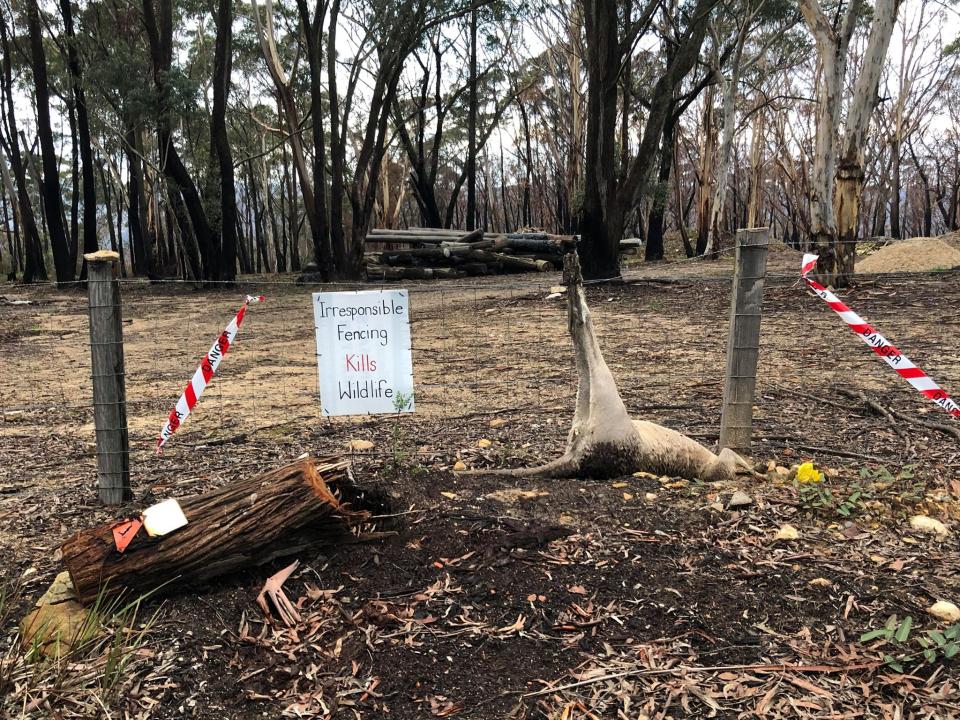'Shredded': Call for rethink of barbed wire fencing after horrendous deaths
WARNING - DISTRESSING CONTENT: Rusted barbed wire cutting through our rugged landscape is a quintessentially Australian vista, but for wildlife rescuers these fences often evoke feelings of sadness and anger.
Untangling the slashed and bleeding limbs of kangaroos, birds and bats is a common task for animal rescuers, but by the time they get to the animal, it’s often too late.
Last Sunday, a crimson rosella was so badly entangled, the wire had to be cut to free it from a fence around a property in Nangkita, 56km south of Adelaide.
Wildlife Welfare Organisation CEO Rena Robinson told Yahoo News Australia that animals become caught up in the barbs which stretch out in many directions.
“Once it’s got you, you just can’t get off it,” she said.
“The more flapping and the more frantic they are, the more damage happens.”

Ms Robinson shared images of the rosella to social media after having to euthanise the bird, and is now urging a rethink of Australia’s barbed wire fencing tradition.
“I just think it’s something that’s entrenched in people and in fencing, and this is how you build it,” she said.
“I see people putting new fences up on properties and they’ve have posts, and then the wire, and then two lines of barbed wire and they don’t even run stock.
“People think that’s how you put up a fence and I don’t know how you’ll ever change that.”

Call for landholders to use alternative fencing
Australia’s largest animal rescue group WIRES has recorded over 75 wildlife species entangled in barbed wire fences in NSW.
They would like to see our native animals able to “freely and safely” travel across their habitat.
WIRES CEO Leanne Taylor told Yahoo News Australia to consider native wildlife and use plain wire or other types of fencing whenever possible.
“WIRES is regularly called out to rescue native animals trapped in barbed wire, usually with substantial injuries caused by their struggles to free themselves,” she said.
“Kangaroos and wallabies are often found with terrible degloving injuries which is where an extensive section of skin is completely torn off the underlying tissue sometimes to the bone.
“Gliders and flying foxes sustain extensive and difficult to treat damage to the delicate membrane on their webbing and wings.”

Rescuers the only hope for tangled animals
Some of the worst affected animals are flying foxes, and unpicking their delicate bodies from the barbs leaves many carers stressed and upset.
Christina Murray from Wildlife Arc spoke to Yahoo News Australia as she nursed a young bat named Hammy, who came into her care last month after being caught in a fence.
The young male presented with a distinct round hole through his wing, but he is one of the lucky ones, given that he is expected to recover.
Ms Murray explained that barbed wire isn’t only used in regional areas, it’s often erected around golf clubs, schools, and other private recreational facilities which cut through the feeding grounds of her beloved bats.
By the time she gets a call to do a rescue, it’s often a race against time to save the animal.

'It's devastating': Concern for threatened animal amid state's trapping plan
The battle to save Australia's dying koalas continues amid coronavirus crisis
The surprising items found in huge rubbish haul from Great Barrier Reef
“Some people don’t ring for a couple of days, so it’s not just their wings that are shredded,” Ms Murray said.
“It’s been hanging in the heat and it’s in pain, so it uses its mouth, sometimes wrecking its pallet by biting into the barbed wire.
“It’s been trying so hard to get off that it’ll inflict pain on itself just to get away.
“Some people think they’ll free themselves, but they never can. It’s sad.”
Ms Murray urges anyone who finds wildlife entangled in barbed wire to contact their local wildlife rescue group as soon as possible.
The author, Michael Dahlstrom, is a registered native bird carer with Wildlife Arc.
Do you have a story tip? Email: newsroomau@yahoonews.com.
You can also follow us on Facebook, Instagram and Twitter and download the Yahoo News app from the App Store or Google Play.



